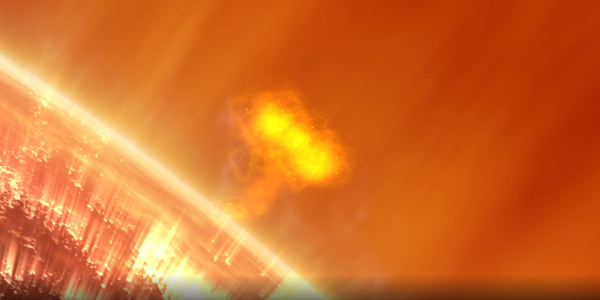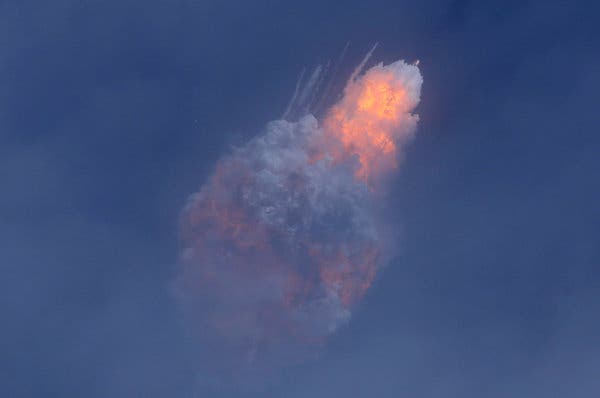KENNEDY SPACE CENTER, Fla. — The rocket launched. It exploded.
SpaceX and NASA declared the blast a success.
Usually the destruction of a rocket means a failed mission. But on Sunday, SpaceX was demonstrating a crucial safety system of its Crew Dragon spacecraft, a capsule that is to carry astronauts for NASA to the International Space Station.
There was no one on board during Sunday’s flight. The passengers this time were two test dummies with sensors to measure the forces that real astronauts would experience if the capsule’s escape system were ever needed. The system proved itself, even during a phase of the flight when atmospheric forces on the spacecraft are most severe. About nine minutes after the test, the intact capsule landed in the Atlantic Ocean.
“Overall, as far we can tell thus far, it was a picture-perfect mission,” said Elon Musk, the founder and chief executive of SpaceX, during a news conference after the test.
This accomplishment may set the stage for opening a new era in spaceflight. For more than eight years since the last space shuttle flight, no person has launched to orbit from the United States. Instead, NASA has had to rely on Russia for the transportation of its astronauts.
Now SpaceX and Boeing, the companies hired by NASA, are nearly ready for their first crewed flights, and probably not just of NASA astronauts.
“We’re on the cusp of commercializing low-Earth orbit,” said Jim Bridenstine, the NASA administrator. “I want to see large amounts of capital flowing into activities that include humans in space. And those activities could be industrialized biomedicine. It could be advanced materials, and it could be people that want to go to space for tourism purposes.”
Boeing and SpaceX may not be the only companies taking people to space from the United States. Two companies, Blue Origin and Virgin Galactic, seem to be on track to carry their first customers on expensive, short-hop space tourism flights soon. The number of people heading toward space could surge, even if most experience weightlessness for just a few minutes.
[Sign up to get reminders for space and astronomy events on your calendar.]
The abort test was postponed one day because of rough seas and gusty winds on Saturday at the planned splashdown site. On Sunday, the waves were beginning to calm, but a storm was moving toward the launchpad.
At 10:30 a.m., conditions on both land and sea were good enough to allow the Falcon 9 rocket to blast off into the sky.
At 84 seconds after liftoff, powerful thrusters on the Crew Dragon pushed the spacecraft away from the rocket quickly, reaching a speed of more than twice that of sound. The rocket then exploded.
Mr. Musk said the capsule, with its heat shield, should be able to survive fiery conditions that erupted before the capsule made its escape.
“It could quite literally look like something out of Star Wars, fly right out of a fireball,” he said. “We want to avoid doing that.”
Coasting to an altitude of more than 130,000 feet, the capsule then performed a carefully designed choreography — jettisoning the bottom of the spacecraft, firing small thrusters and deploying its parachutes — before it splashed into the ocean about 20 miles from where it started.
The next Crew Dragon mission is to take two NASA astronauts, Douglas G. Hurley and Robert L. Behnken, to the space station.
Mr. Musk said that flight would likely occur in the second quarter of the year, between April and June. The Falcon 9 rocket and a new Crew Dragon capsule for that flight will be ready in Florida by the end of February, he said, but safety reviews will take some time.
The crew on the space station is to drop to three in April when three astronauts currently there return to Earth on a Russian Soyuz spacecraft.
The mission for Mr. Hurley and Mr. Behnken is currently scheduled to last two weeks, but could be extended, which would prevent a drop-off in scientific research at the station. For a longer stay, the astronauts would need additional training.
“So far on space station, our responsibility is to take care of ourselves while we’re there, not make a mess,” Mr. Behnken said.
Mr. Bridenstine said that a decision on whether Mr. Hurley and Mr. Behnken would stay longer would be made in a few weeks. He also said that NASA was still negotiating to buy an additional seat on a Soyuz.
“I think it’s important we have options,” Mr. Bridenstine said.
The last time NASA astronauts launched from the United States was July 8, 2011, when the space shuttle Atlantis blasted off on its last flight from Florida.
Thirteen days later, it glided to a landing back at the Kennedy Space Center, where it is now a museum piece. Since then, astronauts from NASA and other nations flying to the space station have been hitching rides on Russian Soyuz rockets, at a current price of more than $80 million each.
From Alan Shepard’s first flight in 1961 through the Apollo moon landings to the space shuttles, NASA was in charge of designing, building and operating its rockets and spacecraft.
After the retirement of the shuttles, NASA planned to continue that approach with the Constellation program started under President George W. Bush. NASA aimed to develop the Ares 1 rocket to take astronauts to the space station.
But costs for Ares 1 and the accompanying Orion capsule kept rising and the schedule slipped repeatedly. The Obama administration canceled the program.
To replace Ares 1, NASA turned to commercial companies, the approach it uses for launches of satellites, cargo to the space station and robotic planetary probes. But relinquishing the transportation of astronauts was a bigger shift for the space agency.
When NASA awarded the commercial crew contracts to Boeing and SpaceX in 2014, the hope was that the flights carrying astronauts would begin by the end of 2017. The contracts set fixed prices, unlike earlier big NASA contracts where contractors were reimbursed for costs with an additional fee.
Watchdogs in government have questioned the management and costs of the program, and both Boeing and SpaceX have suffered technological setbacks along the way. SpaceX successfully sent an uncrewed Crew Dragon to the space station a year ago, and the company was gearing up to conduct the in-flight abort test.
But in April, during a ground test, the capsule that was to be used for the abort test — the same one that had gone to orbit — exploded. No one was injured, but that pushed back SpaceX’s schedule as it figured out what happened and how to fix it.
In December, Boeing launched one of its Starliner capsules without crew, but the mission ended early, without going to the space station, because of a problem with the spacecraft’s clock.
Many space enthusiasts hope that the commercial crew program will spur new business in space.
Last June, NASA announced that it would allow space tourists to make trips to the space station, and one company, Axiom Space, says it has one passenger signed up already for a 10-day trip that will cost $55 million. An Axiom mission could launch as soon as summer 2021.
However, another company, Bigelow Space Operations, which also said it planned to launch space tourists to the station, backed away a few months later.
“NASA still has a substantial amount of work to do,” said Robert T. Bigelow, the founder and chief executive of the company. “We learned last year when we secured a SpaceX launch and options for three others that unfortunately it was premature. So, therefore, we had to cancel those agreements.”
NASA is also expected to soon announce the winner of a competition to attach a commercial module to the International Space Station, providing more room for visitors.
Still, putting people in orbit will most likely remain a small slice of the money invested on space ventures.
“There’s certainly a business to made with human spaceflight,” said Chad Anderson, chief executive of Space Angels, an investment firm focused on start-up space companies. But, he added, his company saw human spaceflight more as a high-profile catalyst than a big business.
The areas of major growth, he said, will be global positioning systems, earth observation and communications, none of which require astronauts.
Closer to the ground, another pair of American companies could take passengers on brief trips to the edge of space.
The spacecraft built by Blue Origin and Virgin Galactic basically just go up and down like a big roller coaster and never accelerate to the speeds needed to reach orbit. Virgin’s officials are optimistically saying that commercial flights will begin this year. Blue Origin has not yet carried any passengers.
Neither company’s trip to space will be in financial reach of the average person. Virgin Galactic charges $250,000 for a seat. Blue Origin has not yet said what it will charge.
But the companies could greatly increase the number of people who travel to space. In the nearly 59 years since Yuri Gagarin became the first person in space, fewer than 600 people have followed him there.

Never miss an eclipse, a meteor shower, a rocket launch or any other astronomical and space event that’s out of this world.








